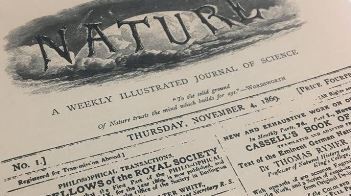Volumes 1-164: 4183 issues
First set, a rich variety of material
The first set of the Nature archive offers a rich variety of material; from original research to book reviews, scientific news, and reports of scientific society meetings. During this period the pages of Nature were home to many of the most significant scientific advances, such as the invention of the typewriter and telegraphs, the science behind and debate around nuclear weapons, the discovery of the neutron, and, in what may have been Nature’s very first special issue, a lively discussion on Einstein’s theory of relativity.
 Use of fingerprints as a way to identify criminals
Use of fingerprints as a way to identify criminals





 Use of fingerprints as a way to identify criminals
Use of fingerprints as a way to identify criminals Watson and Crick decipher the structure of DNA
Watson and Crick decipher the structure of DNA First discovery of a planet outside our solar system
First discovery of a planet outside our solar system Cloning and birth of Dolly the sheep revealed
Cloning and birth of Dolly the sheep revealed Mapping human epigenomes
Mapping human epigenomes